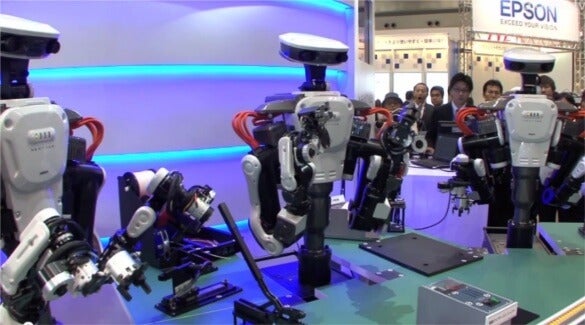A Drop-In Solution for Replacing Human Labor? Kawada’s Nextage Robot

Share
Automation poses a real threat to the factory worker – two armed robots like Nextage can perform many of the same tasks as a human, but only take as much money to run as powering a hair dryer. AIST and Kawada, the developers of Nextage, want to assuage the fears of the working class. Their robot is designed not to eliminate human laborers, but to work side by side with them. The Nextage detects movement and won't collide with people who enter its space. Without the need for safety barriers used with traditional industrial robots, the Nextage may be able to simply plug into spots previously occupied by human workers. In the video below taken in Tokyo, Kawada demonstrates the versatility of the two armed robots, and highlights how multiple Nextage bots can coordinate their movements to work on the same task at the same time. These robots clearly know the value of teamwork, and humans may actually be allowed to be part of that team.
It's been two years since Kawada and AIST first started showing off the Nextage to the world. At first glance, the newest demonstrations below don't seem particularly more advanced than those from 2009. Much of the physical stats of individual bots are the same: twelve degrees of freedom in the arm, stereoscopic vision, and sub-millimeter precision. Yet the newest Nextage demo showcases some key improvements in application. Nextage uses markers on tables to quickly orientate themselves, allowing a single robot to be moved from station to station (and job to job) as needed. Coordination between robots isn't simply done in an assembly line fashion – the robots can manipulate the same objects at the same time to maximize their effect. This 2011 Nextage is flexible enough to work at one station and then be rolled into another station where it essentially becomes part of a larger robot – three bodies, six arms, but one goal.
Where will the humans fit in? It makes sense for most of the repetitive manual tasks to simply be given to robots like the Nextage. It costs ¥7-8 million (~$100,000 USD) but only requires about 1500 watts to run (about the same as a hair dryer). In the long run, robot labor is clearly cheaper. Yet the safety of the Nextage means that some manual tasks (especially those involving rapid decision making) may still rely on humans. That's a combination already seen in other modern factories.
Be Part of the Future
Sign up to receive top stories about groundbreaking technologies and visionary thinkers from SingularityHub.


The ultimate balance between human labor and automation, however, is yet to be decided. Even the Nextage is still being developed. Kawada has a similar platform for researching human-robot interaction called HIRO. The HRP series, of which Nextage is a part, has more than 20 humanoid bots at major research institutions. Finding the most profitable, and sustainable, combination of natural and artificial labor is likely to take some time. However, the goals of Kawada and AIST are clear: with safe robots like the Nextage they will be able to place machines in the same environments, even side by side, with humans to create the future hybrid workforce.
[screen capture and video credit: DigInfo News]
Source: kawada
Related Articles

In Wild Experiment, Surgeon Uses Robot to Remove Blood Clot in Brain 4,000 Miles Away

A Squishy New Robotic ‘Eye’ Automatically Focuses Like Our Own

This Crawling Robot Is Made With Living Brain and Muscle Cells
What we’re reading
